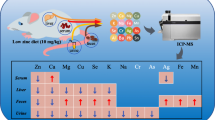Abstract
Enriched stable isotopes were used in nutrition studies of normal, healthy adults to measure zinc, copper, and iron absorption. After obtaining baseline values for zinc, copper, and iron absorption from diets adequate in all nutrients, the effects of age, pregnancy, and deveral dietary variables were studied. Stable isotopes of zinc, copper, and iron were incorporated into diets. Complete fecal samples were collected and the unabsorbed isotopes remaining in the samples were measured by thermal ionization mass spectrometry, the most precise analytical method for the determination of stable mineral isotopes. Stable isotopes were also infused in five young men to evaluate the potential of studying mineral utilization and kinetics with stable isotopes. The results of these studies demonstrate that a number of factors can affect mineral absorption, but the specific effects differ for different minerals. Isotopic enrichments could be measured in urine and blood, so kinetic studies of utilization of essential minerals are now feasible with enriched stable isotopes. Continued use of stable isotopes to determine mineral absorption, combined with stable-isotope studies of mineral utilization, balance data, and biochemical indicators of mineral status, should result in a better understanding of mineral requirements and metabolism under a variety of conditions.
Similar content being viewed by others
References
World Health Organization, Expert Committee, Technical Report No. 532, WHO, Geneva, 1973, pp. 9–15.
National Research Council, Recommended Dietary Allowances, 9th ed., Wash. DC, 1980, pp. 137–144.
L. Wada, J. R. Turnlund, and J. C. King,J. Nutr. 115, 1345 (1985).
J. R. Turnlund, J. C. King, W. R. Keyes, B. Gong, and M. C. Michel,Am. J. Clin. Nutr. 40, 1071 (1984).
J. R. Turnlund, L. A. Acord, A. A. Betschart, M. J. Kretsch, and H. E. Sauberlich,Fed. Proc. 44, 1278 (1985).
C. A. Swanson, J. R. Turnlund, and J. C. King,J. Nutr. 113, 2557 (1983).
J. R. Turnlund, N. Durkin, and S. Margen,Fed. Proc. 43, 850 (1984).
J. R. Turnlund, J. C. King, B. Gong, W. R. Keyes, and M. C. Michel,Am. J. Clin. Nutr. 42, 18 (1985).
J. R. Turnlund, N. Durkin, and S. Margen,Clin. Res. 32, 637A (1984).
J. R. Turnlund, C. A. Swanson, and J. C. King,J. Nutr. 113, 2346 (1984).
M. Janghorbani and V. R. Young,Am. J. Clin. Nutr. 33, 2021 (1980).
D. L. Hachey, J. C. Blais, and P. D. Klein,Anal. Chem. 52, 1131 (1980).
R. Schwartz, D. L. Grunes, R. A. Wentworth, and E. M. Wein,J. Nutr. 110, 1365 (1980).
P. Johnson,J. Nutr. 112, 1414 (1982).
C. Brunnee, G. Kappus, H. Rache, E. U. Seiler, and B. Windel,Am. Lab. 2, 141 (1978).
M. Janghorbani, V. R. Young, J. W. Gramlich, and L. A. Machlan,Clin. Chim. Acta 114, 163 (1978).
P. D. Klein and D. L. Hachey, Personal Communication.
J. R. Turnlund, inBiological Availability of Trace Metals, Elsevier, Amsterdam, 1983, pp. 385–392.
D. L. Smith,Anal. Chem. 55, 2391 (1983).
D. J. Douglas, E. S. K. Quan, and R. G. Smith,Spectrochim. Acta 38B, 39 (1983).
M. B. Rabinowitz, G. W. Wetherill, and J. D. Koppell,Science,182, 725 (1973).
C. S. Irving, W. W. Wong, R. J. Shulman, E. O. Smith, and P. D. Klein,Reg. Integ. Comp. Physiol. 114, R190 (1983).
Author information
Authors and Affiliations
Rights and permissions
About this article
Cite this article
Turnlund, J.R. Zinc, copper, and iron nutrition studied with enriched stable isotopes. Biol Trace Elem Res 12, 247–257 (1987). https://doi.org/10.1007/BF02796684
Issue Date:
DOI: https://doi.org/10.1007/BF02796684




